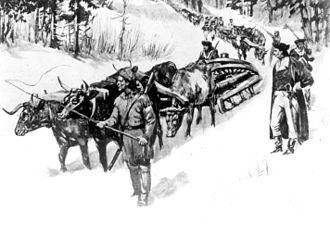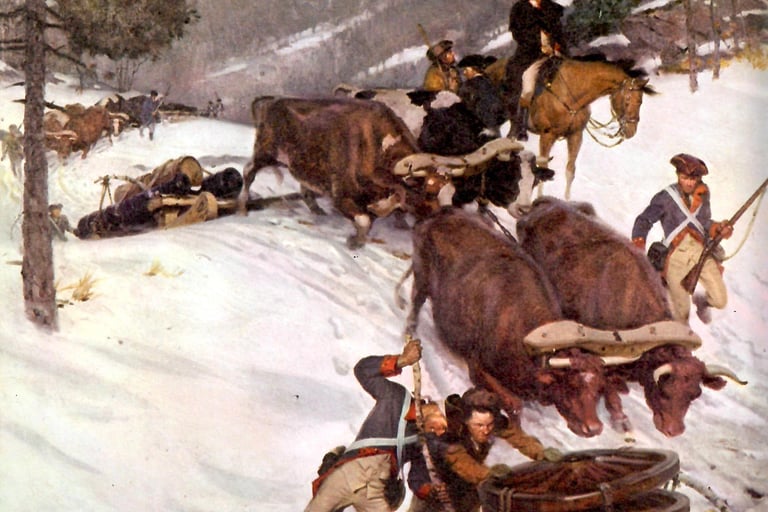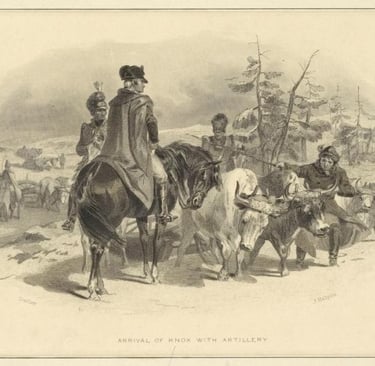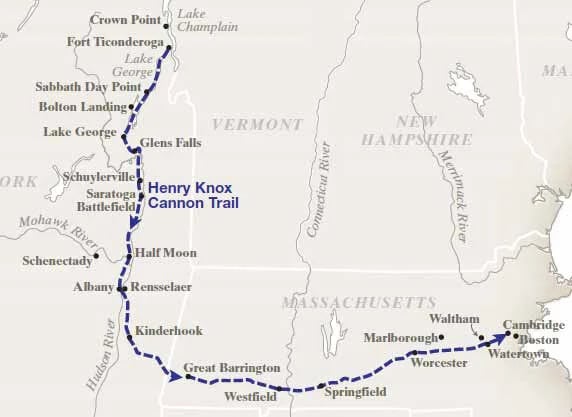Underappreciated Heroes of the Revolution #3 - "A Pretty Good 'Bottom of the Barrel'"
This is Post #3 in my series on lesser-known heroes of the Revolutionary War period. Today will focus on a Founding Father I've always been surprised more people don't know, but who I think just got pushed aside by lack of reputation (and maybe too nice a guy?). Henry Knox was a key general throughout the war, as well as the very first Secretary of War in George Washington's initial cabinet . . . but alongside Jefferson, Adams, and of course Hamilton . . ?
Jay LeBlanc
11/19/20255 min read
OK, you finally get an underappreciated Revolutionary War "hero" who did NOT get depicted in the "Johnny Tremain" movie! As I mentioned in the intro, I've always been surprised more people don't know who Henry Knox is, considering he is "on the scene" of so many of George Washington's accomplishments throughout the Revolutionary War and into the early years of the United States. I can only assume that he simply got pushed to the background by the presence of so many "stars", especially during Washington's presidency.
The informal title I gave this post comes from a quote from eminent historian Richard Brookhiser during the History Channel's video adaptation of Joseph Ellis's Pulitzer Prize-winning
"Founding Brothers", focusing on the first 20 years or so of the new
nation. In the clip, Brookhiser is speaking about the initial cabinet
Washington puts together in 1789 to advise him (since nothing like that
exists in the Constitution). Brookhiser goes on to say, "What a great
cabinet, just for starters . . . you have Hamilton at Treasury, and
Jefferson at State, and you've got Henry Knox at War. So Henry Knox is
kind of the 'bottom of the barrel' . . . which is a pretty high bottom
of the barrel!"
One reason I think Washington quickly grew to like Henry Knox is
the fact that they were both self-made men. Unlike many of the leaders
in the Founding generation who went to college, both Washington and
Knox had fathers who died early, leading them into the world of work
at a relatively early age. It is also worth observing that while most of
the pictures of Henry Knox show him as a older (and fairly overweight)
man, he was a contemporary of younger men like Hamilton and Madison
- in his 20s during most of the war. And maybe most importantly, Washington appreciated a subordinate who could take initiative and get the job done - for example, his command of the artillery at the Battle of Bunker Hill and his efforts to place artillery during the seige of Boston before Washington's arrival to take command. Later, he proposes a mission in the winter of 1775-1776 to Fort Ticonderoga to move the cannon there across hundreds of miles of barely-passable roads and trails back to Boston, leading to the end of the siege and the evacuation of the British army.
Henry Knox serves as chief of artillery and one of General Washington's most trusted advisors throughout virtually the entire war, rising to the rank of Major General by the end of the war. Answering a trivia question I always wondered about, he was the second commander of the Continental Army once George Washington resigned his commission and returned to Mount Vernon, though he only stayed in that role a few more months before he moved on to other tasks.
He served as the United States Secretary at War under the Articles of Confederation, and was one of the most influential voices who convinced George Washington to "come out of retirement" to first lead the Constitutional Convention, and later serve as the 1st President. At that point Henry Knox's title changed to Secretary of War, and as noted earlier he served in that role for 6 years until 1795, when dissatisfaction with the army's efforts to pacify Native American tribes in the Great Lakes region led to his resignation. Like many Revolutionary War veterans, he took land granted to them by Congress and settled in Maine for the rest of his life, dying in 1806 (sadly, of an infection caused by swallowing a chicken bone).
One other argument for Henry Knox's importance is simply the events he was involved in . . .
An eyewitness (at the age of 20) at the Boston Massacre - and later testified at the trial
Unknown if he participated in the Boston Tea Party, but he did serve as a guard of the tea ships beforehand
Directed American cannon fire during the Battle of Bunker Hill
Planned and implemented the earthworks for the Siege of Boston
With Washington throughout the battles in New York City and New Jersey through 1776
In charge of logistics during Washington's crossing of the Delaware and Christmas attack on Trenton
Established armories in Massachusetts and Pennsylvania to improve the army's artillery manufacturing capability
Led artillery in battles like Brandywine, Germantown, and Monmouth through the middle years of the war
Established the Continental Army's first school for artillery and officer training (the precursor to West Point)
Directed the siege cannon at Yorktown (final battle for Washington's army)
Day-to-day command of the Continental Army for most of 1783 and early 1784
Organized the Society of the Cincinnati to support the widows and orphans of Revolutionary War officers
Drafted plans for the establishment of a peacetime army, to include army and naval academies
Today Henry Knox is probably best remembered for the city (Knoxville, Tennessee) and the fort (Fort Knox, KY - where they store the gold!) named after him, rather than his many accomplishments listed above.
Henry Knox Education Resources:
"Henry Knox", Wikipedia, last edited Nov 2025, https://en.wikipedia.org/wiki/Henry_Knox
"The Revolutionary War Couple Who Shed Their British Loyalty—One Letter at a Time", (subtitled "Henry and Lucy Knox Sacrificed Family, Home, and Beliefs to Adopt Their New American Identity"), What It Means to be an American: A National Conversation Hosted by the Smithsonian and Arizona State University, Apr 2018, https://whatitmeanstobeamerican.org/identities/the-revolutionary-war-couple-who-shed-their-british-loyalty-one-letter-at-a-time/
"Historic Fort Knox: The man behind the namesake, Henry Knox", U.S. Army, Feb 2025, https://www.army.mil/article/283375/historic_fort_knox_the_man_behind_the_namesake_henry_knox
PRIMARY SOURCE Classroom Activity - "Henry Knox’s Order of March to Trenton, 1776", Gilder-Lehrman Institute of American History, https://www.gilderlehrman.org/history-resources/spotlight-primary-source/henry-knox-order-march-trenton-1776 (Note the discussion questions at the end of the activity)
"Henry Knox", George Washington's Mount Vernon, Mar 2025, https://www.mountvernon.org/library/digitalhistory/digital-encyclopedia/article/henry-knox
"Big Guns For Washington: How tough Henry Knox hauled a train of cannon over wintry trails to help drive the British away from Boston", American Heritage Magazine, Apr 1955, https://www.americanheritage.com/big-guns-washington
"Top 20 Wartime Quotations from the Letters of Lucy and Henry Knox", Journal of the American Revolution, Nov 2023, https://allthingsliberty.com/2023/11/top-20-wartime-quotations-from-the-letters-of-lucy-and-henry-knox/










